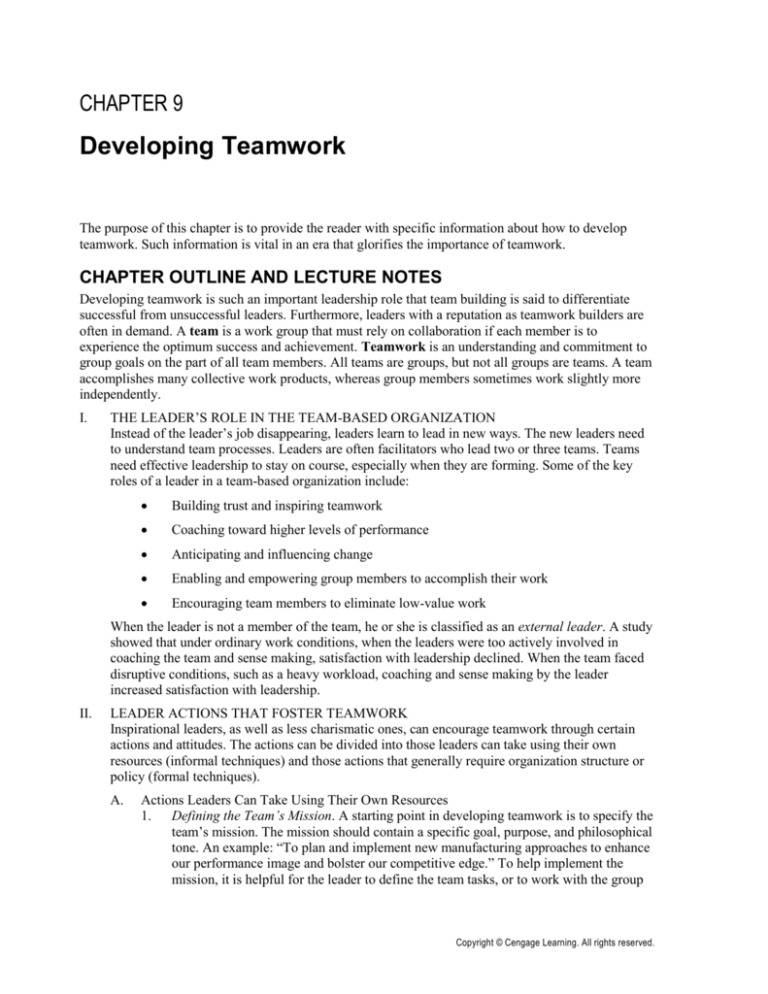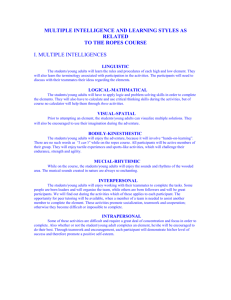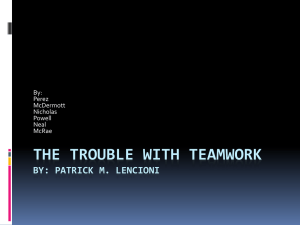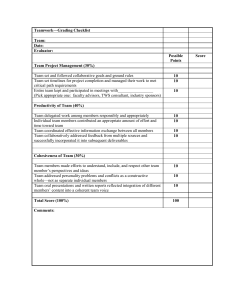
CHAPTER 9
Developing Teamwork
The purpose of this chapter is to provide the reader with specific information about how to develop
teamwork. Such information is vital in an era that glorifies the importance of teamwork.
CHAPTER OUTLINE AND LECTURE NOTES
Developing teamwork is such an important leadership role that team building is said to differentiate
successful from unsuccessful leaders. Furthermore, leaders with a reputation as teamwork builders are
often in demand. A team is a work group that must rely on collaboration if each member is to
experience the optimum success and achievement. Teamwork is an understanding and commitment to
group goals on the part of all team members. All teams are groups, but not all groups are teams. A team
accomplishes many collective work products, whereas group members sometimes work slightly more
independently.
I.
THE LEADER’S ROLE IN THE TEAM-BASED ORGANIZATION
Instead of the leader’s job disappearing, leaders learn to lead in new ways. The new leaders need
to understand team processes. Leaders are often facilitators who lead two or three teams. Teams
need effective leadership to stay on course, especially when they are forming. Some of the key
roles of a leader in a team-based organization include:
Building trust and inspiring teamwork
Coaching toward higher levels of performance
Anticipating and influencing change
Enabling and empowering group members to accomplish their work
Encouraging team members to eliminate low-value work
When the leader is not a member of the team, he or she is classified as an external leader. A study
showed that under ordinary work conditions, when the leaders were too actively involved in
coaching the team and sense making, satisfaction with leadership declined. When the team faced
disruptive conditions, such as a heavy workload, coaching and sense making by the leader
increased satisfaction with leadership.
II.
LEADER ACTIONS THAT FOSTER TEAMWORK
Inspirational leaders, as well as less charismatic ones, can encourage teamwork through certain
actions and attitudes. The actions can be divided into those leaders can take using their own
resources (informal techniques) and those actions that generally require organization structure or
policy (formal techniques).
A.
Actions Leaders Can Take Using Their Own Resources
1. Defining the Team’s Mission. A starting point in developing teamwork is to specify the
team’s mission. The mission should contain a specific goal, purpose, and philosophical
tone. An example: “To plan and implement new manufacturing approaches to enhance
our performance image and bolster our competitive edge.” To help implement the
mission, it is helpful for the leader to define the team tasks, or to work with the group
Copyright © Cengage Learning. All rights reserved.
Chapter 9: Developing Teamwork
2.
3.
4.
5.
67
in defining these tasks. Team members can then identify the subtask for which each
member has responsibility.
Establishing a Climate of Trust. Without team members trusting each other, and
trusting the leader, working together cooperatively is unlikely.
Developing a Norm of Teamwork and Emotional Intelligence. A major strategy for
teamwork development is to promote the attitude among group members that working
together is an expected standard of conduct. The leader can also communicate the
norm of teamwork by frequently using words and phrases that support teamwork. A
belief in cooperation and collaboration rather than competitiveness as a strategy for
building teamwork is called cooperation theory.
The leader’s role in developing a norm of teamwork can also be framed as the leader
helping the group develop emotional intelligence. The leader creates norms that
establish mutual trust among members. A group identity and group efficacy (feelings
of competence) also help build emotional intelligence. Bringing emotions to the
surface also helps.
Emphasizing Pride in Being Outstanding. A standard way of building team spirit, if
not teamwork, is to help the group realize why it should be proud of its
accomplishments. Most groups are particularly good at some task.
5.
Serving as a Model of Teamwork Including Power Sharing. . A powerful method of
fostering teamwork is for the leader to be a positive model of team play. One way of
exemplifying teamwork is for the leader to reveal important information about ideas
and attitudes relevant to the group’s work. Frequent interaction with the team also
helps. Sharing power improves teamwork because a good team player avoids hogging
power and making all the decisions. Exerting power gives team members a feeling of
being a major contributor to the team effort.
6. Using a Consensus Leadership Style. Consensus decision making enhances teamwork.
Contributing input to important decisions helps foster the feeling among group
members that they are valuable team members. The consensus leadership style reflects
a belief in shared governance and partnership instead of patriarchal caretaking.
Generation X managers are likely to practice consensus leadership because they are
good at collaboration and consensus building.
7. Establishing Urgency, Demanding Performance Standards, and Providing Direction.
Team members need to believe that the team has urgent, constructive purposes. The
more urgent and relevant the rationale for the team’s purpose, the more likely it is that
the team will achieve its potential. To help establish urgency, it is helpful for the leader
to challenge the group regularly.
8. Encouraging Competition with Another Group. One of the best-known methods of
encouraging teamwork is to rally the group against a real or imagined threat from the
outside. The leader should encourage rivalry, not intense competition that might lead to
unethical business practices.
9. Encouraging the Use of Jargon. The symbolic and ritualistic framework of a group
contributes heavily to teamwork. An important part of this framework is a specialized
language that fosters cohesion and commitment.
10. Minimizing Micromanagement. A strategic perspective on encouraging teamwork is
for the leader to minimize micromanagement, the close monitoring of most aspects of
group members’ activities. Avoiding micromanagement facilitates empowerment. The
contingency leader recognizes the fine line between avoiding micromanagement and
Copyright © Cengage Learning. All rights reserved.
68
Chapter 9: Developing Teamwork
not providing the guidance and accountability that team members may need to function
well as a unit.
11. Practicing E-Leadership for Virtual Teams. E-leadership is a form of leadership
practiced in a context where work is mediated by information technology. The focus of
leadership shifts from individuals to networks of relationships because the Internet
facilitates connecting so many people. An example of e-leadership to facilitate
teamwork would be establishing chat rooms to solicit opinions from members of a
cross-border virtual team before reaching a final decision. Suggestions for building
teamwork within a virtual team include the following:
a) Solicit volunteers when feasible.
b) Ensure that the task is meaningful to the team and the company.
c) Establish and maintain trust through the use of information technology.
d) Ensure that diversity in the team is understood, appreciated, and leveraged.
e) Maintain frequent communication, including virtual meetings.
f)
Monitor team progress through the use of technology.
B. Actions Generally Requiring Organization Structure or Policy
1. Designing Physical Structures That Facilitate Communication. Group cohesiveness,
and therefore teamwork, is enhanced when team members are located close together
and can interact frequently and easily. A shared physical facility also helps.
2. Emphasizing Group Recognition and Rewards. Giving rewards for group
accomplishment reinforces teamwork because people receive rewards for what they
have accomplished collaboratively. Methods of team recognition include celebrations
of milestones, painting equipment in team colors, and a Team-of-the-Month award.
3. Initiating Ritual and Ceremony. Ritual and ceremony afford opportunities for
reinforcing values, revitalizing spirit, and bonding workers to one another and the
teams. An example is holding a team dinner whenever the group achieves a major
milestone, such as winning bid on a contract.
4. Practicing Open-Book Management. In open-book management every employee is
trained, empowered, and motivated to understand and pursue the company’s business
goals. In this way the employees become business partners, and they perceive
themselves to be members of the same team.
5. Selecting Team-Oriented Members. A heavy-impact method of building teamwork is
to select team members who are interested in and capable of teamwork. A starting
point is self-selection. Many managers believe that individuals who participate in team
sports, now, or in the past, are likely to be good team players on the job.
6. Using Technology That Enhances Teamwork. Workers can collaborate better when
they use information technology that fosters collaboration, often referred to as
groupware. Frequent email messages, text messages, and electronic brainstorming also
assist teamwork. The Web is now used to synchronize the various aspects of design
with suppliers, leading to better collaboration.
III. OFFSITE TRAINING AND TEAM DEVELOPMENT
Offsite or outdoor training is a well-known experiential approach to building teamwork and
leadership skills. Wilderness training is closely associated with outdoor training except that the
setting is likely to be much rougher. In both outdoor training and wilderness training, participants
are supposed to acquire leadership and teamwork skills by confronting physical challenges and
exceeding their self-imposed limitations. Some forms of outdoor training take place in city parks,
as well as in the city itself to rehabilitate or build a house.
The goals of outdoor training include (1) discovering your strengths and weaknesses, (2) testing
your limits, and (3) having the opportunity to break through barriers between yourself and others.
Copyright © Cengage Learning. All rights reserved.
Chapter 9: Developing Teamwork
A.
69
Features of Outdoor and Offsite Training Programs
Participants are placed in a demanding outdoor environment. They have to rely on skills they
did not realize they had and on each other to complete the program. Emphasis is placed on
building self-confidence, leadership, and teamwork. The list of team-building activities
continues to grow and now includes tightrope walking, adventure racing, and cooking.
(Waterboarding is among the latest.) Building or repairing houses for people in need is
gaining in popularity as a form of team building.
Outward Bound is the best-known and largest provider of outdoor training programs.
Courses typically run from three days to four weeks. The Outward Bound Professional
Development Program is geared toward organizational leaders because it emphasizes
teamwork, leadership, and risk taking. Frequent activities include jumping from high places
while attached to a rope pulley and falling backward into the arms of other participants
(“trust falls”).
Outdoor training enhances teamwork by helping participants examine the process of getting
things done through working with people. In going through the exercises, they have to
communicate well and trust one another.
B.
Evaluation of Outdoor Training for Team Development
Outdoor trainers claim that their programs improve self-confidence, help people appreciate
their strengths, and teach people to work better with one another. Many training directors
also speak positively of outdoor training. Reservations about outdoor training include the
fact that it is physically dangerous and that the teamwork training does not carry over to the
job. Also, real workplace teams change membership rapidly, thus negating some of the team
building that the group experienced during the training. Another problem with outdoor and
offsite training is that some participants perceive the experience as wasting time and
sometimes distasteful.
One way to facilitate the transfer of training from outdoors to the workplace is to hold
debriefing and follow-up sessions. The participants review what they have learned and
discuss how they will apply the lessons to the job.
IV. THE LEADER-MEMBER EXCHANGE MODEL AND TEAMWORK
The leader-member exchange model developed by George Graen and associates helps explain
why one subgroup in a unit is part of a cohesive team and another group is excluded. The leadermember exchange model (LMX) proposes that leaders develop unique working relationships
with group members. One subset of employees, the in-group, is given additional rewards,
responsibility, and trust in exchange for their loyalty and performance. The in-group becomes part
of a smoothly functioning team headed by the formal leader. Out-group members are less likely to
experience good teamwork.
A.
Different-Quality Relationships
Leaders treat each member somewhat differently, with the links that exist between the leader
and each individual team member differing in quality. When the quality of the relationship is
high, the member is “in” with the leader. Leaders and group members liking each other is a
major contributor to the quality of the relationship. A study found that when the leadermember exchange is high, group members are more strongly committed to company goals.
An industrial study found that high-quality exchanges between managers and employees
contribute to employees’ engaging in extra-role behavior, or being cooperative in ways not
expected of them. A study with sixty-four group leaders found that positive leader-member
exchanges were associated with more communication about safety, leading to more
Copyright © Cengage Learning. All rights reserved.
70
Chapter 9: Developing Teamwork
commitment to safety, and fewer accidents on the job. A study showed that positive leadermember exchanges may facilitate the leader having a transformational effect.
B.
V.
First Impressions
The leader’s first impression of a group member’s competency plays an important role in
placing the member into the in-group or out-group. Another key linking factor is whether the
leader and team member have positive or negative chemistry. A study showed that the initial
leader expectations of group members and member expectations of the leader were good
predictors of the leader-member exchanges at two weeks and six weeks.
GUIDELINES FOR ACTION AND SKILL DEVELOPMENT
Improving teamwork through office design is receiving considerable attention. Here is how the
leader/manager can customize space to promote teamwork: (1) create common areas, (2) put
yourself in the center, (3) set up multipurpose rooms, and (4) insert “activity generators” such as a
coffee pot or reception desk to draw traffic.
COMMENTS ON EXPERIENTIAL EXERCISES
Leadership Self-Assessment Quiz 9-1: The Teamwork Checklist
An advantage of this teamwork checklist is that it reflects the observations of a teamwork consultant.
The items do not duplicate the suggestions for teamwork made in this chapter and therefore provide
additional insights into teamwork.
Leadership Skill-Building Exercise 9-1: Shelters for the Homeless
This exercise offers yet another opportunity for practicing teamwork. Our experience with the previous
editions of the text is that the content of this exercise has high intrinsic interest and thus leads to
enjoyable student interactions. Of note, this approach to team building is now widely practiced by
companies.
Leadership Self-Assessment Quiz 9-2: Team Player Attitudes
A useful issue for the modern worker to confront is the extent to which he or she really does enjoy
teamwork. Not everybody is inclined toward working in a team. Such individuals might seek work that
gives ample opportunity for working alone.
Leadership Self-Assessment Quiz 9-3: Overcoming
Micromanagement
Given that this quiz has only four questions, the score may not have high reliability. However, the
author of the quiz provides the quiz-taker with some useful ideas about overcoming tendencies toward
micromanagement. My impression is that students enjoy discussing micromanagement. Also, bring up
the topic of macromanagement (a manager who does not provide enough structure) because it is a new
concept for most students.
Leadership Skill-Building Exercise 9-2: The Newapaper Shelter
This exercise has particular appeal if you want to conduct a representative team-building exercise in
class that emphasizes both cognitive and motor skills. As with most team-building exercises that are
representative of offsite training, it consumes time. However, students usually find an exercise of this
nature to be relevant and beneficial to their learning of teamwork.
Copyright © Cengage Learning. All rights reserved.
Chapter 9: Developing Teamwork
71
Leadership Skill-Building Exercise 9-3: Trust Me
The Trust Me exercise is more complicated than the standard trust fall, therefore offering the possibility
of greater student involvement. The exercise also gives students more data to work with in terms of
making observations about teamwork.
COMMENTS ON DISCUSSION QUESTIONS AND ACTIVITIES
1.
What would be the potential disadvantages of selecting a team leader who is highly charismatic
and visionary?
A highly charismatic leader will often set himself or herself off from the group, and group
members might rely heavily on his or her judgment. As a consequence, leadership will not be
distributed to the extent it should be in a true team.
2.
Identify several collective work products from any group in which you have worked.
Collective work products often take the form of useful suggestions stemming from brainstorming
sessions. Many software developments stem from group problem solving, as do ideas for new
products and product development. A good answer here is to identify the output from group
problem solving.
3.
Imagine yourself as the team leader, and the gang invites you to join them for an after-hours drink
at a bar. From the standpoint of enhancing teamwork, explain if joining the team would be
effective.
Although this discussion question may appear innocuous, a major challenge the team leader faces
is to figure out how much to socialize with the group. A key variable here is that a team leader is
also a team member, so it is usually appropriate to socialize with team members. Interacting with
team members socially will usually foster teamwork. Knowing the team leader at a social level
will often facilitate communication in the workplace.
4.
Is there a role for independent-thinking, decisive, and creative leaders in a team-based
organization? Explain.
Despite all the favorable press about team-based organizations, decisive, creative, and
independent-thinking leaders are still in demand. Independent leaders of this type are particularly
in demand for key corporate positions, such as a CEO hired with the assist of an executive
recruiter.
5.
What forces for and against being a good team player are embedded in American culture?
Among the forces for being a good team player embedded in the American culture are the
American obsession with team sports and the extensive use of cooperative (team) learning
throughout the school system. A major force against teamwork is the glory Americans attach to
individual achievement like that of superstars in sports and other forms of entertainment, and the
attention paid to successful business executives—even after all the scandals.
6.
As the team leader, should you dress in about the same fashion as the rest of the team? Or, should
you dress a little fancier? Explain your reasoning.
An appropriate response to this question depends to a large extent on how the student perceives
the role of the team leader. If the team leader is perceived as having higher status than the other
team members, the student would probably want to dress a shade fancier. However, if the student
perceives a team leader to be an equal with the rest of the team, he or she would probably want to
dress the same. Traditional advice is for the leader/manager to dress a shade fancier than do group
members.
Copyright © Cengage Learning. All rights reserved.
72
7.
Chapter 9: Developing Teamwork
What can a team leader, who is a telecommuter, do to enhance teamwork among his or her team—
who are also telecommuters?
Common practice for enhancing teamwork among telecommuters is to communicate frequently by
electronic means with team members. Teamwork is more likely to be reinforced if the
communication is collaborative, such as interacting on a wiki-style site or a common whiteboard.
The telecommuters should also get together for an occasional face-to-face meeting. With crossborder teams this is much more difficult.
8.
What is your opinion of the value of experience in team sports for becoming a good team player
in the workplace?
Most people see a carryover from team play in sports to team play in the workplace. When polled
on the subject, the majority of executives think that team sports help prepare a person for being a
team member on the job. So people who oppose this idea would face a lot of opposition.
9.
Why would team-building activity of preparing a gourmet meal lead to enhanced teamwork on the
job?
Preparing a gourmet meal, particularly for beginners, requires extensive cooperation and
coordination. Most decisions are made by consensus. If these coordinated behaviors are carried
over to the job, better teamwork will result.
10. How can political skill help a person avoid being adversely affected by the leader-member
exchange model?
By using political skill, the group member can get on the good side of the leader and thus avoid
becoming an out-group member. The political actor must work fast, because first impressions
count heavily in forming the quality of the leader-member exchanges.
PLAUSIBLE RESPONSES TO CASE QUESTIONS
Leadership Case Problem A: Why Can’t We Work Like a Real Team?
An important feature of this case is that it illustrates that a small business, such as an automobile
dealership, is dependent on it success to teamwork.
1.
What do you recommend that leadership at Crystal Motors do to enhance teamwork in the service
department?
Service department members may not be intuitively aware of the importance of teamwork.
Although scheduling would be difficult, a dealership outing, such as a picnic, might emphasize the
importance of teamwork. A bonus program based on profits in the service department might be
another way of reinforcing teamwork.
2.
What different contributions might Ventura and Magellan make in enhancing teamwork in the
service department?
Ventura might provide more strategic direction for teamwork, such as emphasizing that the
dealership’s goal is to bring about a higher level of teamwork. He might also be able to set up
policies, such as team bonuses, to emphasize teamwork. Magellan might be more involved in the
implementation of formal and informal activities to encourage teamwork. She might establish, for
example, a “high-performing team” award.
Copyright © Cengage Learning. All rights reserved.
Chapter 9: Developing Teamwork
3.
73
What do you recommend that the team leaders (red, blue, etc.) do to get the service technicians
and general workers to cooperate better with each other?
The team leaders need to reinforce good teamwork, and discourage poor teamwork, day by day.
Positive feedback might be offered for good team play, and negative feedback for poor team play.
Some of the technicians may not have thought about the importance of cooperation and teamwork.
4.
In what way is a pit crew, as referred to by Magellan, an effective team?
A pit crew in automobile racing requires highly coordinated, world class teamwork. Each crew
member has a precise role to execute (such as left rear wheel changer) in a compressed time
frame. All these fast actions must be accomplished without interfering with the work of other
team members. Because the pit crews usually accomplish their goal, they are a highly effective
team.
Leadership Case Problem B: Over the Top at Bell ExpressVu
This case illustrates some of the potential problems associated with off-site team building, particularly
when it appears that gender discrimination has taken place. The case also points to the potential
problems inherent in teambuilding with extreme physical demands.
1.
What has this story about the fired executives have to do with team building?
The implied link to team building in this story is that the two executives were fired because they
did not participate fully in the teambuilding exercises. The implication is that the two executives
were fired because they were perceived to be poor team players.
2.
Based on the descriptions provided by Boutilier and Green, how professionally was the retreat
conducted?
If the descriptions provided by Boutilier and Green are accurate, the retreat was quite
unprofessional. The martial arts theme of “over the top,” lent itself to physical contact among
participants. Wearing war paraphernalia is also likely to be perceived as unprofessional.
3.
What recommendations might you offer management at Bell ExpressVu for offsite, teambuilding
activities?
Management at Bell ExpressVu should look for less extreme retreat activities, including such
forms of team building as building shelters for the homeless, refurbishing the homes of poor
people, cleaning parks, and gourmet cooking. Working with horses is another pleasant, nonthreatening teambuilding activity. Many teambuilding consultants offer teambuilding activities
that are non-controversial and that do not involve potentially dangerous physical contact.
Copyright © Cengage Learning. All rights reserved.





![Teamwork [doc]](http://s3.studylib.net/store/data/007119492_1-4f52bf0b0aa8b7482c84777d359de0b7-300x300.png)


